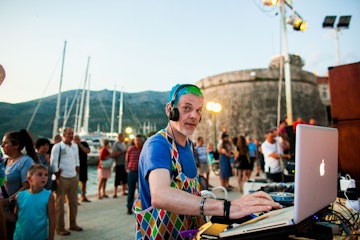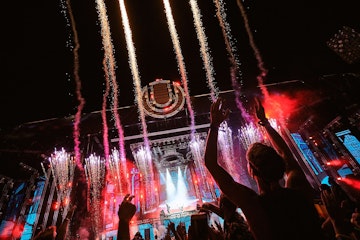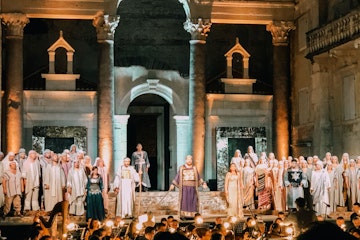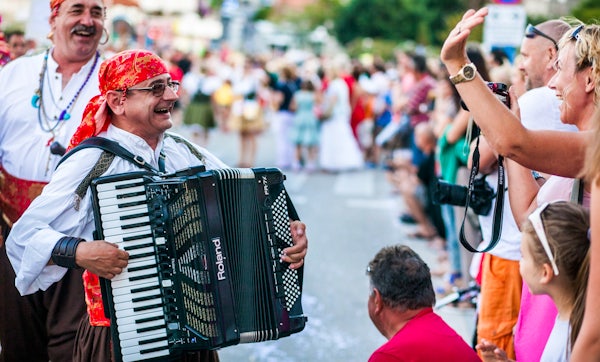Rich in all things art and culture, music is another genre that definitely does not fall short in Croatia!
Croatia’s music scene is as varied as its archipelago. Between tradition and modern rendition, Croatian music is favoured as much by locals as it is internationally.
History of Croatian Music
Between medieval, romanticism, renaissance and baroque, Croatia’s history of music dates back centuries. The oldest preserved artefacts date from the medieval era around the 11th to 15th century. A shift was noticed thereafter during the renaissance and baroque period where music was enjoyed outside of religious walls and celebrated domestically. During the 16th century, folk music was immortalised by way of transcripts which was usually passed down by word of mouth.
Folk/Traditional Music
Croatia sits in a unique position, given its location, and its music varies depending on the region. The music is juxtaposed with influences from Central Europe, the Mediterranean as well as the Balkans all providing a rich folk approach. The Croatian music culture is highly regarded and celebrated throughout the country and many forms have been registered in UNESCO’s list of Intangible Heritage including some styles below!
Klapa
Along the Dalmatian Coast, Klapa is the most prominent type of singing. Klapa consists of a group, predominantly males, harmonising in a-capella. Klapa translates to ‘a group of friends’ who sing of love and loss and it serves as a way of passing down the tales of Croatian history.
Whilst their voices play the major part, Klapa musicians are often accompanied by a tamburica or mandolin – think mini guitar – accordion, and double bass. It’s also more common than not that these singers wear a traditional costume, ‘nošnje’, as they’re performing.

Tamburica
The most common and popular music genre of traditional Croatian music is the Tamburica, with its name coming from the instrument itself. The national folk string instrument is a fusion of the Russian Balalaika, the Ukranian Bandura and Italy’s mandolin, and is thought to be traced back as far as the 14th century. The tamburica is played and usually accompanied with a dance but has always been used as a way of passing down songs from generation to generation. Group ensembles can have anywhere from 3 to 10 players and can include various additional instruments depending on the region.
Other
There are more forms of folk music that are affiliated with Croatia and include Ganga, distinguished by the type of singing, Gusle, played on a traditional Dalmatian string instrument signifying historical or patriotic events, and Diple which is a traditional woodwind instrument played from Istria, Lika and Dalmatian islands. It’s also very common to come across accordions when discovering Croatian folk music.
What Kind of Music do Croatian’s Listen to?
Aside from folk, modern music in Croatia has increased in popularity across a number of genres. You may be surprised to learn that there are many famous Croatian artists, from bands, soloists and even the classical and well known Two Cellos!
Croatian Pop Music
Unlike what you’d expect from western pop, Croatian pop music incorporates hints of native traditional music! Croatia’s pop scene erupted during the 1980’s which saw a spike in group performers. Some of those local legends include Magazin and Grupa 777. Solo artists don’t fall short either with household names including the likes of Severina, Tajci and Oliver Dragojevic.
Speaking of, spanning over a 4 decade career, music great Oliver Dragojevic is considered a cultural icon of Croatia and holds a special accreditation within the country. Expect to find a blend of traditional, jazz and modern melodies throughout his discography.
Naturally, Croatia’s pop scene has adapted to the times and new age artists are embracing the sounds of modern trends. Keep your ears peeled for Croatian songs from artists like Lana Jurčević, Lidija Bačić and El Bahaette!
Croatian Rock
Croatia’s rock music emergence also began at the turn of the 1980’s during a new wave known as ‘Novi val’ regarded by many as the pinnacle of Croatian rock. The rock scene brought about many artists and groups with a large number of them maintaining a long standing career. Some of these headbangers include Parni Valjak, Crvena Jabuka, Tutti Frutti Band, Azra and Paraf.
Croatian Dance
Where pop, western influence and euro disco meet, Dance music came to be. Sprung in the late 1980’s and early 1990’s, Dance music quickly rose in popularity and welcomed electronic artists of house, techno and trance. Artists come by the plenty but special mention goes out to Dino Dvornik and bands E.T and Colonia who paved the way during the ‘90s for this genre. E.T and Colonia still remain active however Colonia’s popularity prevails and are one of the most popular bands in Croatia today!

Croatian Rap/Hip-Hop
Rap gained popularity in Croatia during the 1990’s as a way to express political views. This brought about a sizable number of rappers as well as rap bands including The Beat Fleet (TBF) who were the first to reach recognition. Popular artists range from Tram 11, Bolesna Braca and the duo Nered & Stoka whilst the band Elemental gained interest for featuring a female rapper which is currently a limited area in the industry. Whilst there’s a strong history of Croatian rap, hip-hop falls a little short, however The Ugly Leaders were the first Croatian group to release a hip-hop album particularly popular in Rijeka.
Croatian Music Festivals
For the modern music aficionado, Croatia is world-renowned. From critically acclaimed festivals to electronic music performed at clubs and beachfronts, modern Croatian music is eagerly sought after!
Music festivals come by the dozen throughout the summer, showcasing various genres, international music sensations and hidden local talent. Festivals that are synonymous with Croatia are the iconic Ultra Music Festival, Hideout Music Festival and Love International, to name a few. Music seekers from all over the world hold out for the summer to gear up and see some of the world's hottest DJ’s! Major headlines are sure to leave you speechless, but listening to the local talent is worth your time as well. Lucky for you, we run our Ultra Music Festival and Hideout Festival cruises in June and July in Split and Zrce, meaning we take care of all of the heavy lifting for you, and all that’s left is for you to do is party the day (and night) away.

If the heavy beats of EDM tunes aren’t for you, which for many they’re not, there’s still great music all over Croatia. Throughout the summer, Split Summer Festival, Dubrovnik Summer Festival and the International Folklore Festival are all in full swing, and allow you to experience traditional, classical and live celebrations in a more demure environment. Think regional orchestras and historic theatres all coming together to showcase the cultural history of Croatian music.

Croatian music will naturally pop up whilst you’re travelling throughout the towns. Whether you’re looking for traditional serenades or the party of the year, there is music for every type of traveller in Croatia to enjoy and leave an everlasting impression.


